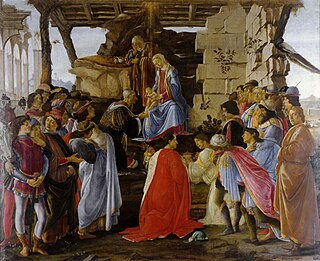 W
WThe Adoration of the Magi is a painting by the Italian Renaissance master Sandro Botticelli, dating from 1475 or 1476, early in his career. The work is on display at the Uffizi in Florence. Botticelli was commissioned to paint at least seven versions of The Adoration of the Magi. This version was commissioned by Gaspare di Zanobi del Lama for his funerary chapel in Santa Maria Novella.
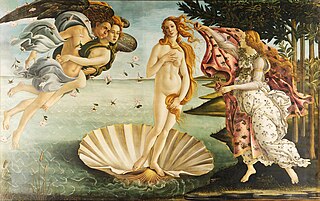 W
WThe Birth of Venus is a painting by the Italian artist Sandro Botticelli, probably made in the mid 1480s. It depicts the goddess Venus arriving at the shore after her birth, when she had emerged from the sea fully-grown. The painting is in the Uffizi Gallery in Florence, Italy.
 W
WThe Calumny of Apelles is a panel painting in tempera by the Italian Renaissance painter Sandro Botticelli. Based on the description of an ancient lost painting by Apelles, the work was completed in about 1494–95, and is now in the Uffizi, Florence.
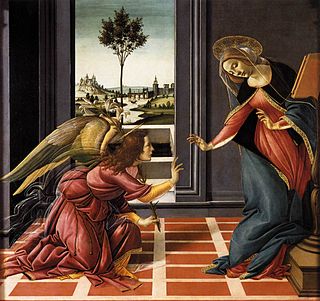 W
WThe Cestello Annunciation, is a painting in tempera on panel made in 1489 by Sandro Botticelli. It was painted for the patron Benedetto di Ser Giovanni Guardi to adorn the church of the Florentine monastery of Cestello, which is now known as Santa Maria Maddalena de'Pazzi.
 W
WThe Fortitude is a painting by the Italian Renaissance master Sandro Botticelli, finished in 1470. Housed in the Galleria degli Uffizi, in Florence, Italy, Fortitude was the first recorded masterpiece by Botticelli.
 W
WThe Madonna and Child with an Angel is a painting by the Italian Renaissance painter Sandro Botticelli, c. 1465–1467. It is housed in Spedale degli Innocenti of Florence.
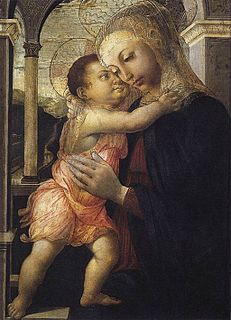 W
WThe Madonna della Loggia is a painting attributed to the Italian Renaissance artist Sandro Botticelli, dating to c. 1467. A tempera on panel work, it is located in the Uffizi, Florence, Italy.
 W
WMadonna in Glory with Seraphim is a painting by the Italian Renaissance painter Sandro Botticelli, executed c. 1469–1470. It is housed in Galleria degli Uffizi, Florence.
 W
WThe Madonna of the Magnificat, Italian: Madonna del Magnificat, is a painting of circular or tondo form by the Italian Renaissance painter Sandro Botticelli. It is also referred to as the Virgin and Child with Five Angels. In the tondo, we see the Virgin Mary writing the Magnificat with her right hand, with a pomegranate in her left, as two angels crown her with the Christ child on her lap. It is now in the galleries of the Uffizi, in Florence.
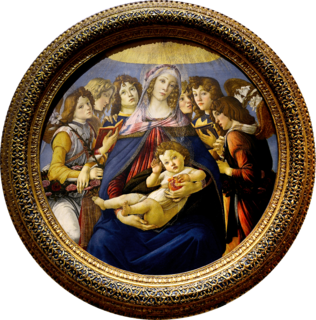 W
WThe Madonna of the Pomegranate was painted in circa 1487 with tempera on a wood panel by Sandro Botticelli. Sandro Botticelli is a well known Italian Renaissance artist from Florence, Italy. The use of the circular format, better known as a tondo, focuses the attention on the main characters, the Virgin Marry and baby Jesus, who are surround symmetrically by angels on each side. Botticelli's use of tempera grassa give the characters a real look, better known as a "naturalistic" style, which is common during the Renaissance. The Virgin Mary is holding baby Jesus gently in her arms while holding a pomegranate in her left hand. The pomegranate being displayed has a few different interpretations of its meaning in the religious piece. There are many replicas of the Madonna of the Pomegranate due to artists during the Renaissance would copy other established artists' artwork to master their own skills. The painting is currently on display at the Uffizi Gallery in Florence, Italy.
 W
WPallas and the Centaur is a painting by the Italian Renaissance painter Sandro Botticelli, c. 1482. It is now in the Uffizi Gallery in Florence. It has been proposed as a companion piece to his Primavera, though it is a different shape. The medium used is tempera paints on canvas and its size is 207 x 148 cm. The painting has been retouched in many places, and these retouchings have faded.
 W
WPortrait of a Man with a Medal of Cosimo the Elder, also known as Portrait of a Youth with a Medal, is a tempera painting by Italian Renaissance painter Sandro Botticelli. The painting features a young man displaying in triangled hands a medal stamped with the likeness of Cosimo de' Medici. The identity of the young man has been a long-enduring mystery. Completed in approximately 1475, it is on display in the Uffizi Gallery of Florence.
 W
WPrimavera, is a large panel painting in tempera paint by the Italian Renaissance painter Sandro Botticelli made in the late 1470s or early 1480s. It has been described as "one of the most written about, and most controversial paintings in the world", and also "one of the most popular paintings in Western art".
 W
WSaint Augustine in His Study, is a painting by the Italian Renaissance master Sandro Botticelli, finished around 1490–1494. It is housed in the Uffizi, in Florence.
 W
WThe Madonna and Child with Six Saints, also known as Sant'Ambrogio Altarpiece, is a painting by the Italian Renaissance master Sandro Botticelli, finished around 1470. It is housed in the Galleria degli Uffizi, in Florence.